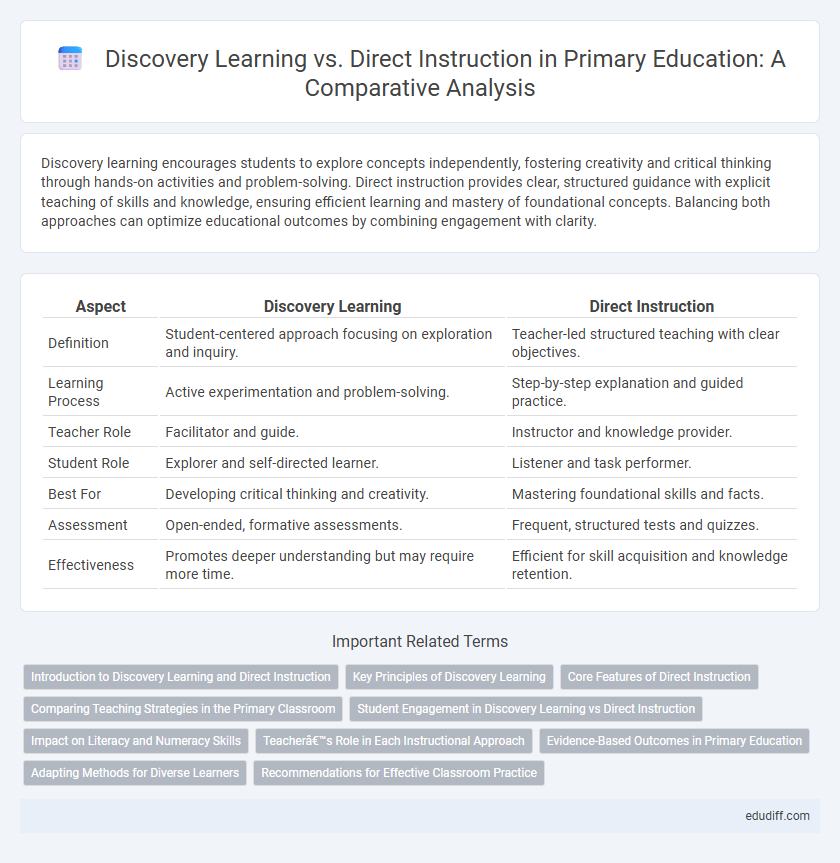Discovery learning encourages students to explore concepts independently, fostering creativity and critical thinking through hands-on activities and problem-solving. Direct instruction provides clear, structured guidance with explicit teaching of skills and knowledge, ensuring efficient learning and mastery of foundational concepts. Balancing both approaches can optimize educational outcomes by combining engagement with clarity.
Table of Comparison
| Aspect | Discovery Learning | Direct Instruction |
|---|---|---|
| Definition | Student-centered approach focusing on exploration and inquiry. | Teacher-led structured teaching with clear objectives. |
| Learning Process | Active experimentation and problem-solving. | Step-by-step explanation and guided practice. |
| Teacher Role | Facilitator and guide. | Instructor and knowledge provider. |
| Student Role | Explorer and self-directed learner. | Listener and task performer. |
| Best For | Developing critical thinking and creativity. | Mastering foundational skills and facts. |
| Assessment | Open-ended, formative assessments. | Frequent, structured tests and quizzes. |
| Effectiveness | Promotes deeper understanding but may require more time. | Efficient for skill acquisition and knowledge retention. |
Introduction to Discovery Learning and Direct Instruction
Discovery learning encourages primary students to explore concepts through hands-on activities and inquiry-based approaches, fostering critical thinking and problem-solving skills. Direct instruction, by contrast, uses explicit teaching methods with clear, structured lessons and immediate feedback to ensure mastery of foundational knowledge. Both methods serve distinct educational purposes, with discovery learning promoting creativity and engagement, while direct instruction emphasizes efficiency and accuracy in skill acquisition.
Key Principles of Discovery Learning
Discovery learning emphasizes active exploration, allowing learners to construct knowledge through hands-on experiences and problem-solving. It prioritizes curiosity-driven inquiry, fostering critical thinking and deeper understanding by encouraging students to find solutions independently. The approach supports learner autonomy, with the teacher acting as a facilitator who guides rather than directly imparts information.
Core Features of Direct Instruction
Direct Instruction emphasizes structured, explicit teaching methods that prioritize clear, systematic lesson presentation and step-by-step guidance to ensure student mastery of foundational skills. It incorporates scripted curricula, frequent assessment, and immediate feedback to promote efficient learning and minimize misconceptions. This approach supports skill reinforcement through repetition and controlled practice, fostering high academic achievement in primary education.
Comparing Teaching Strategies in the Primary Classroom
Discovery Learning encourages active exploration and critical thinking in primary students, fostering deeper conceptual understanding through hands-on activities and inquiry-based tasks. Direct Instruction, characterized by structured, teacher-led explanations and practice, ensures clarity and mastery of fundamental skills, which is particularly effective for teaching foundational literacy and numeracy. Comparing these strategies highlights that combining Discovery Learning's promotion of creativity with Direct Instruction's systematic guidance optimizes engagement and academic achievement in primary classrooms.
Student Engagement in Discovery Learning vs Direct Instruction
Discovery learning fosters higher student engagement by encouraging active exploration and problem-solving, which enhances curiosity and intrinsic motivation. Direct instruction, while more structured and efficient in delivering content, may result in lower engagement due to its passive reception format. Studies show that students involved in discovery learning demonstrate increased attention and participation, contributing to deeper understanding and retention.
Impact on Literacy and Numeracy Skills
Discovery learning enhances critical thinking and problem-solving abilities in literacy and numeracy by encouraging exploration and active engagement with concepts. Direct instruction promotes mastery of foundational skills through structured, explicit teaching, leading to faster acquisition of reading and mathematical procedures. Combining both approaches can optimize literacy comprehension and numeracy fluency, tailoring learning experiences to diverse student needs in primary education.
Teacher’s Role in Each Instructional Approach
In discovery learning, the teacher acts as a facilitator who guides students through exploration and encourages problem-solving, fostering independent thinking and inquiry. In contrast, direct instruction requires the teacher to take an authoritative role, delivering clear, structured lessons with explicit explanations and demonstrations to ensure mastery of specific skills and knowledge. Effective classroom management and continuous assessment are critical for teachers to adapt their role according to the learning approach and student needs.
Evidence-Based Outcomes in Primary Education
Evidence-based outcomes indicate that discovery learning enhances critical thinking and problem-solving skills in primary education, fostering deeper conceptual understanding. Direct instruction demonstrates higher effectiveness in improving foundational skills like literacy and numeracy, showing more consistent short-term academic gains. Combining both methods tailored to student needs maximizes learning retention and cognitive development in early education.
Adapting Methods for Diverse Learners
Discovery learning encourages active exploration, fostering critical thinking and problem-solving skills tailored to diverse learners' needs. Direct instruction offers structured, clear guidance that supports students requiring explicit steps and immediate feedback. Adapting these methods based on student abilities and backgrounds enhances engagement and maximizes educational outcomes in primary classrooms.
Recommendations for Effective Classroom Practice
Discovery learning encourages active student engagement and fosters critical thinking, best supported by structured guidance and timely feedback from teachers. Direct instruction proves most effective when lessons are clearly sequenced with explicit objectives and frequent formative assessments to monitor understanding. Blending both methods by scaffolding exploratory activities within a well-organized framework maximizes learning outcomes in primary classrooms.
Discovery Learning vs Direct Instruction Infographic

 edudiff.com
edudiff.com